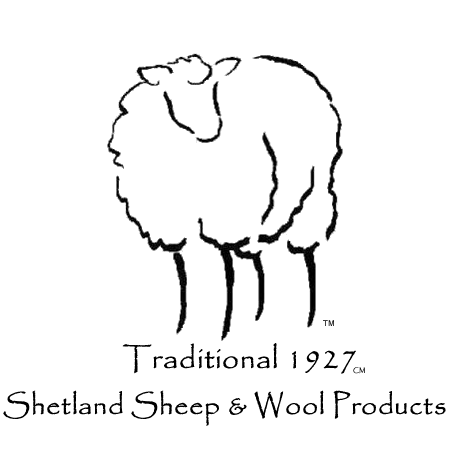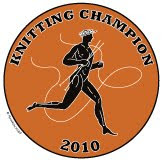The circumstantial evidence (Bunker's actions, last year's failure to settle) leads me to believe that Bramble is not breedable. She doesn't act like a ram in any way, so I do not think she is a hermaphrodite; perhaps she is messed up because of the in utero hormonal influence of her male twin. I know, I know; some people don't believe "freemartins" occur in sheep. However, a quick Google search on the topic brought up a scientific article which states, "The biology of freemartin sheep has recently been studied in detail, and the condition may be increasing in prevalence with the introduction of high fecundity genes into flocks." I remember reading with surprise some time ago that historically, twinning was not a desirable trait on the Shetland Isles. Something to think about when we select for lines known to produce multiples over those that single!
 In other non-news, my homespun two-color scarf is off the needles but still needs to be blocked. I have patterns and yarn for two other projects at the ready; I just need to pull out the appropriate needles so I have something to work on during my free period at our homeschool co-op and during Brian's weekly science class.
In other non-news, my homespun two-color scarf is off the needles but still needs to be blocked. I have patterns and yarn for two other projects at the ready; I just need to pull out the appropriate needles so I have something to work on during my free period at our homeschool co-op and during Brian's weekly science class.Speaking of the homeschool co-op, last week I was racking my brain over a class to teach. Parents are responsible for teaching at least two classes per three-term year; this term, like I did last spring, I am facilitating a WWII Living History class for the high-schoolers. I've taught Figure Drawing to high-schoolers three times, so feel like that needs a time-out for a year or two. The Hippology class I taught was fun, but I taught that to grades 3-6 and need to wait another year to have two suitable classes (grades 3 & 4) again (I won't teach it to Brian's class because he'll try to take over). I've toyed with teaching something related to fiber, but have been too intimidated to tackle that. Well, after discussing it with a couple other moms and sketching out the barest of outlines in my mind, I signed up for a winter term class for the 6th graders. EEEK! I plan to approach it with a short history on textiles, followed by a simple, hands-on "sheep to shawl" type of thing - taking them through the steps wool goes through from raw wool to end product. I don't know how involved to make it; I have access to fleece, of course, and have hand cards, combs (that belong to Laura), a drum-carder, a crockpot for dyeing with Kool-Aid, and figured I can make CD spindles for the kids and end up with them finger-knitting and/or finger-crocheting a trivet/potholder (and use Brian's simple peg loom to demonstrate weaving). The logistics scare me, though. I know it will take a lot of time and effort to haul the various materials and tools back and forth from home to class and back each week. How much time will it take to explain and demonstrate each step? Will the students have adequate time each week to practice what they learned? We have eight classes of 50 minutes each to do this. If you have any experience and/or great ideas, please
That's it for today from . . .








12 comments:
Oh, I've not taught anything, but just recently on Spin-List a retired elementary teacher mentioned using "fiber craft" to teach chemistry (dyeing), social studies (processing and spinning), coordinating grids (weaving) and history (making cloth).
Informally, I've used knit and purl as an allegory for how DNA works. And shucks, it seems like the Industrial Revolution pretty much revolved around mechanizing textile production. And then sheep breeds are a great example of breeding for particular traits as an example of genetic manipulation. Uhm, I probably didn't offer anything helpful specifically to your teaching a class.
Shelly
I know for a fact I had a freemartin ewe (blackface/montedale cross). She was VERY attractive to the boys. They'd break in to her pen to get access. When we finally took her to the auction, she weighed 300 lbs!
I've spent a day introducing my youngest's 6th grade social studies class to fiber processing. Took in fleece, hand cards, spinning wheel. Let the kids try everything (some of those kids still talk about it, and this was 9years ago!). We also talked about the time required to go all the way from sheep to sweater vs commercially done.
A group of us have also gone into one of the elementary schools and done a day long sheep fest for the 4th graders. We cover several stations and rotate the kids thru - husbandry, knitting, spinning, dyeing, felting. Lots of fun!
Goodness, Shelly, I think you've given brief outlines for at least a half-dozen courses - university-level ones, at that! Now, how to boil that down into eight class periods for 6th graders, hmmm? (-;
Susan, wanna come help me???
That is an aweful lot to cram into 8 classes. Of course you'll want as much hands-on activity as possible for each class. Six graders tend to have the attention span of a gnat. Budding hormones I think. Good luck!
Oh my, I just spent the afternoon yesterday with a young MALE spinner who had a very informative educational display. I will post about this tomorrow. He has done numerous demonstrations, I think you could do a GREAT series of interesting classes about this!
Is there any way to find out for certain if Bramble is sterile?
Don't forget to talk about water conservation in the dyeing portion of the lessons. The chemicals (natural or otherwise) in water can alter the way dye takes. :-)
If you want to be easy, kool-aid or cake dye is great for kids and the dyeing makes a powerful impact on the kids. Of course, it isn't period type of stuff.
Felting is a good hands on project as well. It allows the kids to be very creative. Little scarves are fast and cute to make. Small bags, felted balls or bracelets, are also very easy. The kids can dye the wool the first time, hand card the wool next, lay it out on their own plastic the next, wet felt the next, and finish it for a fifth/sixth+ time. It would take working hard but may be doable. Just make sure the particular fleece/s you use are conducive to easy felting.
The sheep to shawl class I taught at the Living Arts and Science Center went really well. You'll have fun with this!
http://myfavoritesheep.blogspot.com/2010/06/each-one-teach-oneor-nine.html
Sound ambitious, but will be great! Kids like to be able to "do" something. Joelle
Thanks for mentioning water conservation, Kat; that's an excellent point to make!
Theresa, I'm not trying to do "period," so no worries; I'm planning to use Kool-Aid. The non-Shetland wool I have readily available (my fleeces sold out) doesn't felt and I have no experience with wet-felting, so I wasn't going to go there except to mention it.
Thank-you so much for the link, Sara! Couldn't you leave the farm in Saint Tim's care and come out to help me???
Mom, you commented!!! Love you!
I was checking facts/figures with Correy about freemartinism in sheep. It's actually been determined that the incidence is about the same as in cattle - 6-12%. The reason it's not noticed more is that most sheep are eaten before they reach breeding age. There has been a technique to check heifers before breeding, determining the length of the vagina from opening to cervix; if it's shorter than the norm, they are shipped to slaughter. Don't know if that's really do-able for sheep, but would make someone a great research project!
As for your class - the more hands-on the better. A caution, however: don't even take the combs to class... take a picture and blow it up or something. All it takes is one kid to pick them up carelessly and someone will get hurt. Heck - I hurt myself with them and I KNOW how to use them!!
I agree with Laura on the losing the combs. My friend Lauren is developing a fiber arts program with her high school at students. She made drop spindles, using fimo clay or the spindles, then she had the kids work in teams of two to learn how to spindle. One would spin the spindle and the other would feed the fiber. It worked well.
Post a Comment